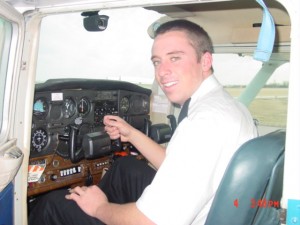The winds were calm and the sun was bright with blue skies surrounding when Sinclair Community College Aviation student Michael McDougall took off for his first solo flight in a Cessna 152.
“Honestly, if I told you I was totally calm and cool, I’d be lying,” he said about his nerves during the flight. “I just felt like I was ready. I was totally prepared and knew what I was doing.”
McDougall knew weeks before his March 4 take off that he would be behind the controls of his first flight. The accomplishment occurred at the Dayton Wright Brothers Airport in Miamisburg.
“It felt like I lost track of time,” he said.
A solo flight consists of three full-stop landings, according to McDougall. The accomplishment took one hour, but McDougall said it didn’t feel like it.
Emily Watson, McDougall’s certified flight instructor at Sinclair Community College, asked McDougall if he was ready for his first solo and he gave an extremely confident ‘yes’ to Watson.
“The greatest part about being an instructor is sitting there watching your student,” said Watson, who also helps train potential pilots using the General Aviation Trainer (GAT).
Simulator training
The GAT is more difficult than flying a plane, according to Watson, because of its sensitivity to movement. The GAT is a flight simulator used by students aspiring to become pilots. It’s located in the first floor of Building 13.
“It’s actually a lot harder to fly than a real plane,” Watson said. “If a student can fly the GAT, it makes them a better student at flying the real plane. It’s definitely beneficial.”
McDougall had no simulator time before his solo, but is going through the training in spring quarter. After gaining experience both in the air and in the GAT, McDougall agrees with Watson.
“The GAT controls are more touchy and sensitive,” he said. “If you can fly well in the GAT, then you’ll have no problem with the plane.”
Watson is in her second quarter helping train students with the GAT. Students are not required to train with the simulator, but Watson said it helps the smooth the transition to the air.
“When you fly a real plane, whatever control input that you do the aircraft will respond accordingly,” Watson said. “When you fly the simulator, it’s over-sensitive. It makes you more alert. It makes you pay attention more to what you’re doing.”
Training with the GAT is not required in order to receive an associate’s degree.
Watson said the best way to judge a pilot’s ability is the confidence and skill level.
“Safety is the most important part of flying,” she said. “As soon as they can demonstrate they know how to land that plane and do everything that they’re supposed to do. Confidence is the big thing.”
Next departure for McDougall
McDougall began taking classes last summer and plans on finishing his associate’s degree in 2010 and move on to Ohio University, Ohio State or Embry-Riddle Aeronautical University in Daytona, Fla.
One of his earliest and fondest memories linked to aviation happened at 7 years old when McDougall took a seat next to the pilot in a six-seated passenger jet.
“The pilot let me get in the front seat and fly some of it, which I thought was pretty neat,” he said.
McDougall’s next solo flight isn’t scheduled yet, but he has cross-country solo flights consisting of around 55-60 miles, according to McDougall.
“It should be easy,” said McDougall on his next solo flight. “Once you make it over the hump, it’s pretty easy.”


